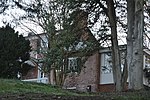Oakhurst–Gildersleeve Neighborhood Historic District
Buildings and structures in Charlottesville, VirginiaCharlottesville, Virginia Registered Historic Place stubsColonial Revival architecture in VirginiaHistoric districts on the National Register of Historic Places in VirginiaNRHP infobox with nocat ... and 3 more
National Register of Historic Places in Charlottesville, VirginiaTudor Revival architecture in VirginiaUse mdy dates from August 2023

Oakhurst–Gildersleeve Neighborhood Historic District is a national historic district located at Charlottesville, Virginia. The district encompasses 78 contributing buildings in a primarily residential section of the city of Charlottesville. It was developed between 1910 and the 1960s and includes examples of the Bungalow, Colonial Revival, and Tudor Revival styles.It was listed on the National Register of Historic Places in 2009.
Excerpt from the Wikipedia article Oakhurst–Gildersleeve Neighborhood Historic District (License: CC BY-SA 3.0, Authors, Images).Oakhurst–Gildersleeve Neighborhood Historic District
Oakhurst Circle, Charlottesville
Geographical coordinates (GPS) Address Nearby Places Show on map
Geographical coordinates (GPS)
| Latitude | Longitude |
|---|---|
| N 38.031666666667 ° | E -78.506666666667 ° |
Address
Oakhurst Circle 100
22903 Charlottesville
Virginia, United States
Open on Google Maps








